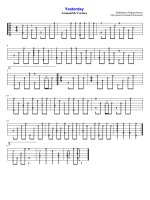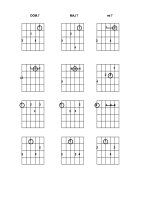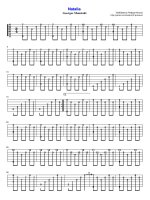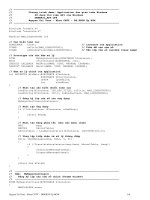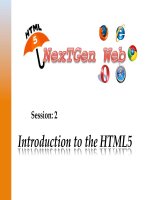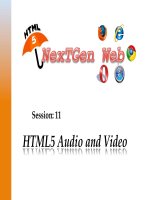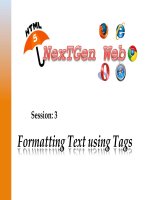HTML5 XP session 10 tủ tài liệu bách khoa
Bạn đang xem bản rút gọn của tài liệu. Xem và tải ngay bản đầy đủ của tài liệu tại đây (6.44 MB, 53 trang )
Session: 10
HTML Forms
HTML5
forms
Describe
Explain
the
working
of
new
input
types
in
HTML5
the
new
Form
aEributes
Explain
Explain
the
new
Form
elements
©
Aptech
Ltd.
HTML
Forms
/
Session
10
2
HTML5 Web forms are those sections on the Web page that contain special elements
called as controls.
The controls, such as check boxes, radio buttons, and text boxes provide a visual
interface to the user to interact with them.
A user provides data through these controls that is sent to the server for further
processing.
In HTML5, creation of form is made easier for Web developers by standardizing them
with rich form controls.
It also provides client-side validations that are now handled natively by the browsers.
This reduces the load time of the pages and also removes the need of the repetitive
JavaScript codes to be included on the page.
Even the visual appearance of the forms is improved when displayed on different
devices, such as iPhone, ipad, touch screens, and browsers.
©
Aptech
Ltd.
HTML
Forms
/
Session
10
3
Web
forms
bring
great
improvements
related
to
form
creaKon
for
the
HTML5
Web
developers
and
also
for
users
interacKng
with
them.
The following are the changes introduced in HTML5 forms:
New
form
elements
New
input
types
New
aEributes
Browser-‐based
validaKon
CSS3
styling
techniques
Forms
API
©
Aptech
Ltd.
HTML
Forms
/
Session
10
4
has
introduced
a
range
of
new
elements
that
are
expanding
the
HTML5
opKons
for
more
number
of
elements
related
to
input
on
the
forms.
Following
table
lists
the
new
elements
in
HTML5.
Data Type
Description
progress
Represents the completion progress of a task on the page
meter
Represents a scale of known range
datalist
Represents a set of options used with list attribute to make a drop-down
control
output
Represents the result of a calculation
©
Aptech
Ltd.
HTML
Forms
/
Session
10
5
The
input
element
is
a
data
field
that
allows
the
user
to
edit
the
data
on
the
form.
has
an
aEribute
named
type
which
controls
the
data
type
and
characterisKcs
It
of
the
input
element.
Following
table
lists
the
new
input
types
supported
by
HTML5.
Type
Description
Represents the completion progress of a task on the page
search
Represents a scale of known range
url
Represents a set of options used with list attribute to make a
drop-down control
tel
Represents the result of a calculation
number
Represents a numeric value in the input field
©
Aptech
Ltd.
HTML
Forms
/
Session
10
6
Type
Description
range
Represents a numeric value to be selected from a range of numbers
date
Represents a calendar which is shown whenever the field is clicked
Week
Represents date in year-week format
month
Represents a value with year-month format
time
Represents a value in hours and minutes format
datetime
Represents a full date and time input field with a time zone
datetime-local Represents a full date and time with no time zone
color
©
Aptech
Ltd.
Represents a predefined interface for selecting color
HTML
Forms
/
Session
10
7
HTML5
has
introduced
several
new
aEributes
that
can
be
used
with
form
and
input
elements.
AEributes
help
the
elements
to
perform
their
tasks.
Following
table
lists
the
new
aEributes
in
HTML5.
Type
Description
placeholder
Represents a hint that help users to enter the correct data in the field
required
A Boolean attribute that validates the entry in the field
multiple
A Boolean attribute that allows multiple values to be entered in the field
autofocus
Focuses the input element on page load
pattern
Represents a regular expression for validating the field’s value
form
Allows the elements to reference the form by including the form name
©
Aptech
Ltd.
HTML
Forms
/
Session
10
8
HTML4 supported the use of custom JavaScript or libraries to perform validation on the
client-side browsers.
These validations ensure that the input fields are checked before the form is submitted to
the server for further processing.
The new attributes in HTML5, such as required and pattern can be used with the input
elements to perform validation.
This relieves the Web developers from writing the custom JavaScript code for
performing client-side validation on the Web pages.
HTML5 also provides advanced validation techniques that can be used with JavaScript
to set custom validation rules and messages for the input elements.
©
Aptech
Ltd.
HTML
Forms
/
Session
10
9
Web
developer
can
enhance
the
form
elements
with
the
pseudo-‐class
A
selectors,
such
as
:required,
:valid,
and
:invalid.
input
fields
which
cannot
be
le[
blank
while
submi\ng
the
form
can
be
The
displayed
with
an
outline
by
styling
the
input
field
using
CSS.
Code
Snippet
shows
the
CSS
code
for
forma\ng
non-‐empty
and
incorrect
The
data
input
in
the
input
element
fields
on
the
form.
<style>
input:required
{
outline: 1px red solid;
color: green ;
}
input:required:valid
{
background-size:10px 10px;
background-position: right top;
background-repeat: no-repeat;
}
©
Aptech
Ltd.
HTML
Forms
/
Session
10
10
input:required:invalid
{
background-size:10px 10px;
background-position: right top;
background-repeat: no-repeat;
}
</style>
</head>
<body>
<form method=”get” action=”try.php”>
Name: <input type=”text” name=”name” required=”true” />
Email: <input type=”email” name=”emailid” required=”true” />
<input type=”submit” value=”submit” />
</form>
………
©
Aptech
Ltd.
HTML
Forms
/
Session
10
11
has
introduced
JavaScript
API
for
forms
to
customize
validaKons
and
HTML5
processing
performed
on
the
forms.
new
Forms
API
provides
new
methods,
events,
and
properKes
to
perform
The
complex
validaKons
combining
fields
or
calculaKons.
Following
table
lists
the
events
and
methods.
Events and Methods
Description
setCustomValidity
(message)
Sets the custom error message that is displayed when the form is
submitted by the user
checkValidity()
Checks the validity of the e-mail address entered by the user
oninvalid
Allows script to run only when the element is invalid
onforminput
Allows script to run when the form run when a form gets a input from
the user
onformchange
Represents a regular expression for validating the field’s value
form
Allows script to run when the form changes
©
Aptech
Ltd.
HTML
Forms
/
Session
10
12
type
aEribute
of
the
input
element
determines
what
kind
of
input
will
be
The
displayed
on
the
user’s
browser.
default
input
is
type=”text”.
The
The
registraKon
form
in
the
session
is
using
the
following
input
types:
text
textarea
label
radio
checkbox
submit
HTML5
has
introduced
more
data-‐specific
user
interface
elements.
©
Aptech
Ltd.
HTML
Forms
/
Session
10
13
type=”email”
is
used
for
specifying
one
or
more
e-‐mail
addresses.
To
The
allow
mulKple
addresses
in
the
e-‐mail
field,
separate
each
address
with
comma-‐
separator.
the
registraKon
form,
the
input
type
is
changed
from
text
to
as
In
shown
in
the
following
code
snippet:
<form method=”get” action=”test.html”>
<label for=”emailid”>Email:</label>
name=”emailaddress” maxlength=”255” />
<input type=”submit” value=”submit”/>
</form>
the
code
snippet,
<label>
tag
defines
a
label
for
the
element
on
the
form.
In
for
aEribute
of
<label>
tag
binds
it
with
the
related
element,
that
is
The
element,
on
the
form.
The
value
of
for
aEribute
must
match
with
the
value
of
id
aEribute
assigned
to
the
element.
contains
two
aEributes,
namely
id
and
name.
The
id
aEribute
specifies
a
unique
id
for
the
element.
The
The
value
of
the
id
aEribute
should
be
unique
within
the
document.
©
Aptech
Ltd.
HTML
Forms
/
Session
10
14
name
aEribute
specifies
a
name
for
the
input
element.
The
look
of
the
input
is
sKll
like
a
plain
text
field,
but
changes
are
applied
behind
The
the
scenes.
such
as
Firefox,
Chrome,
and
Opera
will
display
a
default
error
Browsers,
message
if
user
submits
the
form
with
some
unrecognizable
contents.
figure
shows
the
error
message
for
incorrect
E-‐mail
Address
in
Following
Chrome.
©
Aptech
Ltd.
HTML
Forms
/
Session
10
15
type=”url”
input
element
is
used
for
specifying
a
Web
address.
The
look
of
the
url
field
is
a
normal
text
field.
The
The
Code
Snippet
shows
the
code
of
url
input
type.
<label for=”url”>Enter your Web page address:</label>
maxlength=”255” />
<input type=”submit” value=”submit”/>
such
as
Opera,
Firefox,
and
Chrome
support
validaKon
for
the
url
Browsers,
input
type.
validaKng
the
URL,
browsers
only
checks
for
entry
with
forward
slash
(/).
While
Following
figure
shows
the
error
message
for
incorrect
URL
in
Chrome.
©
Aptech
Ltd.
HTML
Forms
/
Session
10
16
type=”tel”
input
element
is
used
for
accepKng
telephone
numbers.
The
tel
type
does
not
impose
a
parKcular
paEern.
The
supports
characters,
numbers,
and
special
characters
except
new
lines
or
It
carriage
returns.
user
can
enforce
a
paEern
for
tel
input
type
by
using
placeholder,
paEern
A
aEribute,
or
a
JavaScript
code
for
performing
client-‐side
validaKon.
Code
Snippet
shows
the
code
for
including
input
type
on
the
registraKon
The
form.
<label for=”telno”>Telephone Number:</label>
maxlength=”10” />
©
Aptech
Ltd.
HTML
Forms
/
Session
10
17
input
type=”number”
is
used
for
accepKng
only
number
values.
The
input
element
displayed
for
number
type
is
a
spinner
box.
The
user
can
either
type
a
number
or
click
the
up
or
down
arrow
to
select
a
The
number
in
the
spinner
box.
The
Code
Snippet
shows
the
code
for
including
number
input
type
on
the
form.
<label for=”stud_age”>Age:</label>
name=”studentage” min=”15” max=”45” step=”1” />
<input type=”submit” value=”submit”/>
the
code
snippet,
the
number
input
type
has
aEributes,
such
as
min
and
max
In
to
specify
the
minimum
and
maximum
value
for
the
input.
Following
figure
shows
the
input
type
in
Opera.
©
Aptech
Ltd.
HTML
Forms
/
Session
10
18
input
type=”range”
is
similar
to
number
type
and
displays
a
slider
The
control
on
the
page.
range
type
is
used
when
the
exact
value
is
not
required
in
the
input.
The
For
example,
an
online
survey
form
asking
the
clients
to
rate
the
products
may
not
receive
exact
values
in
the
raKngs.
The
Code
Snippet
shows
the
code
for
including
range
input
type
with
aEributes
min
and
max.
<label>Survey for packages offered[scale: 1-10]:</label>
<input type=”range” name=”rating” min=”1” max=”10” />
<input type=”submit” value=”submit”/>
code
snippet,
the
range
input
type
contains
aEributes,
such
as
min,
max,
In
step,
and
value.
min
and
max
aEributes
are
used
to
specify
the
minimum
and
maximum
The
value
allowed
for
a
range
and
are
set
to
1
and
10
respecKvely.
step
aEribute
specify
the
intervals
for
incremenKng
the
value.
The
value
of
step
aEribute
is
1
by
default.
The
value
aEribute
specifies
the
default
value
for
the
range.
The
The
default
value
is
the
midpoint
of
the
range
specified.
©
Aptech
Ltd.
HTML
Forms
/
Session
10
19
Following
figure
shows
the
range
input
type
in
Opera.
figure
shows
the
value
for
the
range
input
type
in
the
URL
a[er
the
Following
form
is
submiEed
by
the
user.
The
raKng
selected
by
the
user
can
be
seen
in
the
Address
Bar
of
the
browser.
©
Aptech
Ltd.
HTML
Forms
/
Session
10
20
has
introduced
several
new
input
types
for
date
and
Kme.
HTML5
format
for
all
these
date
and
Kme
types
is
according
to
the
ISO
standards.
The
present
only
Opera
provides
the
support
for
date
element
by
displaying
a
At
calendar
control.
Ø Date
input
type
contains
only
date
in
year,
month,
and
day
format.
The
Kme
part
This
is
not
support
by
date
type.
The
Code
Snippet
shows
the
code
of
the
date
input
type.
<label for=”stdate”>Date:</label>
min=”2000-01-01”/>
<input type=”submit” value=”Submit” id=”btnSubmit”></input>
the
code
snippet,
all
date
input
types
have
min
and
max
aEributes
to
set
the
In
range
for
the
dates.
default
value
for
date
input
type
is
based
on
the
browsers.
The
Thus,
it
is
advisable
to
set
the
minimum
and
maximum
value
for
the
date
type.
©
Aptech
Ltd.
HTML
Forms
/
Session
10
21
Following
figure
shows
the
input
type.
figure
shows
the
value
sent
for
the
date
input
type
a[er
the
form
is
Following
submiEed
by
the
user.
©
Aptech
Ltd.
HTML
Forms
/
Session
10
22
Ø Month
type=”month”
includes
only
the
year
and
month
in
the
input.
The
The
Code
Snippet
shows
the
syntax
of
month
input
type.
<label for=”stmonth”>Month:</label>
<input type=”month” id=”stmonth” name=”startmonth” />
<input type=”submit” value=”submit”/>
such
as
Opera
will
display
the
date
picker
for
selecKng
month.
Browser
selecKng
any
day
from
the
calendar,
the
whole
month
is
selected.
On
Following
figure
shows
the
date
picker
for
the
month
input
type.
©
Aptech
Ltd.
HTML
Forms
/
Session
10
23
Ø Week
input
type=”week”
provides
a
similar
interface
as
displayed
for
date
The
type
and
selects
the
enKre
week.
The
Code
Snippet
shows
the
syntax
of
the
week
input
type.
<label>Week:</label>
<input type=”week” name=”week” />
<input type=”submit” value=”submit”/>
Following
figure
shows
the
week
input
type
in
Opera.
©
Aptech
Ltd.
HTML
Forms
/
Session
10
24
Ø Time
input
type=”time”
displays
a
Kme
of
day
in
hours
and
minutes
format
The
(24-‐hour
clock).
The
Code
Snippet
shows
the
syntax
of
the
Kme
input
type.
<label>Time:</label>
<input type=”time” name=”time” />
<input type=”submit” value=”submit”/>
Following
figure
shows
the
Kme
input
type
in
Opera.
©
Aptech
Ltd.
HTML
Forms
/
Session
10
25


